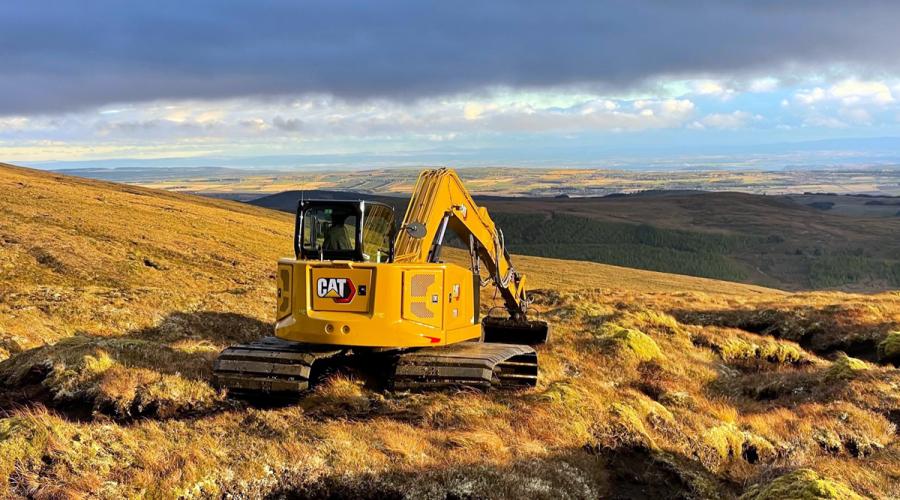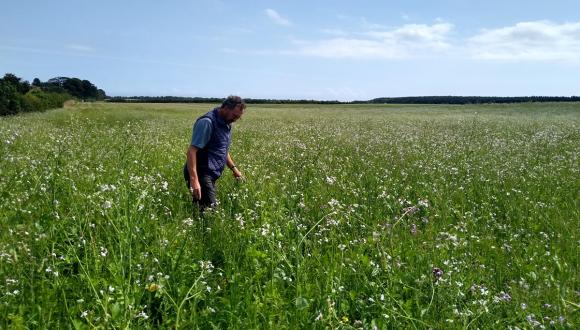
Summit to sea nature restoration continues at Ben Wyvis
29 September 2023
More than 200 hectares of peatland has now been restored on the mountainside at NatureScot’s Ben Wyvis National Nature Reserve (NNR) as part of landscape-scale habitat restoration stretching from summit to sea.
The large area of heavily eroded peat hags and gullies on the eastern slopes of the mountain, near Inverness, has been sensitively restored to re-vegetate the peat, halt erosion and allow the peatland to function properly.
The work, funded by NatureScot Peatland ACTION, has also included blocking historic man-made drains in order to re-wet the site and encourage the growth of sphagnum mosses to form new peat.
In total, 227 hectares has been restored by local contractors Albamontane at the site, which is also a Site of Special Scientific Interest (SSSI) and Special Area of Conservation (SAC).
NatureScot Nature Reserves Manager Ian Sargent said: “In Scotland’s Climate Week we want to shine a light on some of the success stories that offer real inspiration and hope in the face of the twin crises of biodiversity loss and climate change.
“Ben Wyvis NNR is one such success story, where a combination of investment and the hard work of many individuals and organisations pulling together is bringing about real and dramatic change - nature restoration on a landscape-scale that stretches from mountain summit to sea shore. It’s a great example of what can be achieved when we take positive action to protect, restore and value nature, with all the benefits that brings for people as well.”
The work will not only have wide benefits for storing carbon, but also for a variety of species that live on the slopes of Ben Wyvis, as well as wider nature restoration work along the burns and rivers that flow off the hill to the sea at Dingwall.
Peatland restoration will improve conditions for dwarf birch, a nationally scarce and important montane shrub, which is doing well and regenerating naturally on the site. Surveys will be carried out to see how dragonflies and damselflies fare in the recovering habitat.
NatureScot has also been managing deer to much lower numbers at the NNR which has helped to reduce damage by trampling and grazing to both peatlands and woodlands at the reserve.
Meanwhile Forestry and Land Scotland (FLS) is working to move back the edge of the forestry plantation next to the area of peatland restoration which will help to reduce the spread of non-native trees seeding onto the blanket bog, as well as carrying out additional forest to bog restoration on adjacent land.
As the site is at the very top of the River Peffery, the work will also contribute to an ongoing project to restore the river on a whole-catchment scale.
The River Peffery Restoration Project, funded by the Scottish Government’s Nature Restoration Fund, is restoring habitats and exploring natural flood management techniques to help reduce flood risk to Dingwall and benefit biodiversity.
The work has included re-meandering sections of river, planting trees and creating new floodplain habitat. The peatland restoration work complements this by slowing the flow and reducing the amount of sediment in the water coming off the hill. This will make flash flooding less likely further down the catchment, and improve water quality for wildlife in the river.
Richard Lockett, an environmental consultant and local farmer at Knockbain Farm near Dingwall, who is leading the River Peffery Restoration Project, said: “It’s great to see peatland restoration happening in the headwaters of the Peffery. This work will help hold water in the upper reaches of the catchment and reduce downstream flood risk. Taking a catchment scale approach to flooding and river restoration is essential and this is a big step in that direction.”





